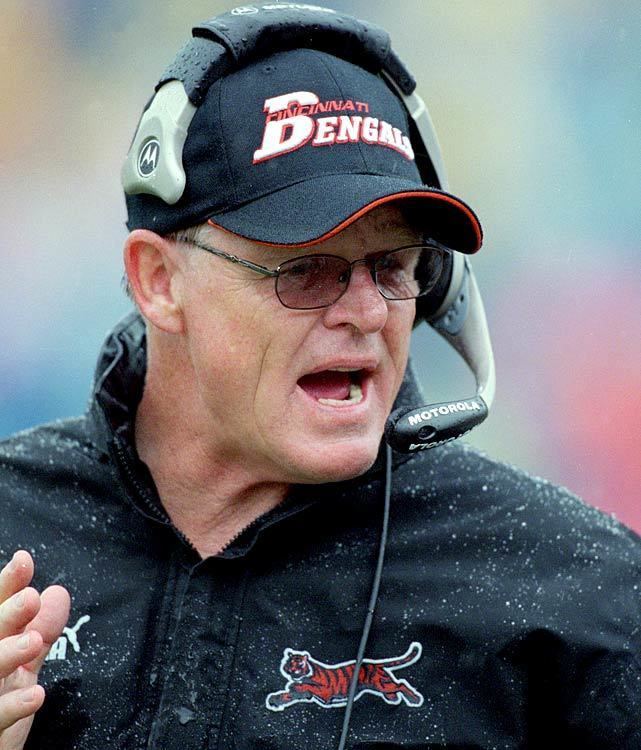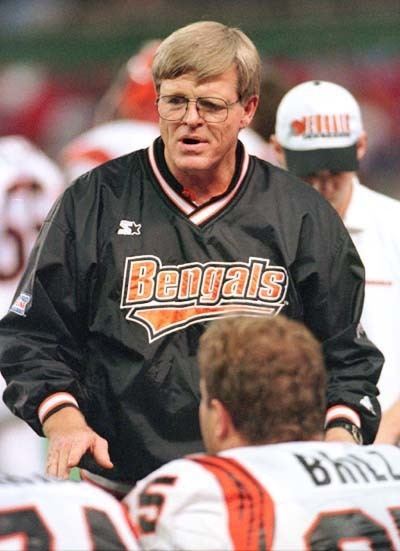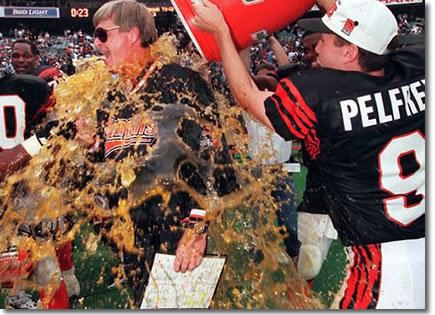College: Pacific | Name Bruce Coslet Role American football player | |
 | ||
Date of birth: (1946-08-05) August 5, 1946 (age 69) | ||
Episode 93 - Bruce Coslet Era - Tour Through Jets History - Part 5
Bruce Coslet (born August 5, 1946) is a former American college and professional football player and professional football coach. A tight end, he played for the University of the Pacific and in 1969 debuted with the American Football League's Cincinnati Bengals. He played for the Bengals in the NFL through 1976.
Contents
- Episode 93 Bruce Coslet Era Tour Through Jets History Part 5
- Early life
- Cincinnati Bengals 198689
- New York Jets 199093
- Return to the Bengals 19942000
- Dallas Cowboys 2002
- Personal life
- References

Early life

Coslet was born in Oakdale, California and graduated from Oakdale High School. He played college football at the University of the Pacific before playing for the Cincinnati Bengals from 1969 to 1976.
Cincinnati Bengals (1986–89)

Coslet was named the offensive coordinator for the Bengals in 1986 under head coach Sam Wyche. In his first year in the position Cincinnati's offense ranked first in the league in total yards and third in total points scored, and the Bengals finished the season with a 10-6 record. It was not enough, however, for the team to make the playoffs as they were one of four teams in the AFC that finished 10-6 and did not have any tiebreakers favoring them. In 1987 the Bengals ranked fifth in total yards under Coslet, but failed to score many points and finished the season with a 4-11 record.

The Bengals' best was yet to come, however, and Coslet's offensive unit finished with the top scoring and top yardage producing offense in 1988. It helped the Bengals finish 12-4 and reach the Super Bowl, only for them to lose to the San Francisco 49ers. Although Cincinnati failed to return to the playoffs in 1989, Coslet's unit was again in the top five in the league as they scored the fourth most points and produced the third most total yards in the NFL.

With his successes as an assistant, Coslet found himself highly sought after as a head coach and was hired by the New York Jets for the 1990 season.
New York Jets (1990–93)
Coslet took over a Jets team that had finished 4-12 under Joe Walton the year before and improved the team's fortunes slightly. The Jets were hovering around .500 for the first half of the season, but a five-game losing streak took away any hope of that. The Jets finished 6-10, winning their last two games of the year against the New England Patriots and the Tampa Bay Buccaneers.
In 1991, the Jets did not start out particularly well as, after an opening week win against Tampa Bay, the team dropped their next three games. Coslet led the team to six wins in their next eight games, putting the Jets into playoff contention, but the team required a win in their final game against the Miami Dolphins after losing three straight games. The Jets won, giving Coslet his first (and what proved to be his only) playoff appearance. New York was quickly eliminated, however, by the Houston Oilers in the wild card round.
Coslet's 1992 team was decimated by injuries and hampered by the ineffective play of new starting quarterback Browning Nagle, who was named the starter after longtime veteran starter Ken O'Brien held out for most of the first half of the season. Two of the injuries proved to be career ending. In Week 10 against the Denver Broncos, star receiver Al Toon suffered the ninth concussion of his career and was forced to retire after the game. Then, in Week 13 against the Kansas City Chiefs, a collision between defensive ends Scott Mersereau and Dennis Byrd left Byrd with a broken neck and temporarily paralyzed. Although the Jets finished 4-12, two of the wins came against AFC East division champion Miami and the eventual AFC champion Buffalo Bills.
The Jets retained Coslet for the 1993 season, but the team made it clear that this unless the Jets somehow qualified for the playoffs he would not return for 1994. To help the Jets make a run toward the playoffs, the Jets acquired Coslet's former starting quarterback with the Bengals, Boomer Esiason, in the offseason. Through thirteen games the Jets looked to be primed to make the playoffs, as a Week 15 win over the Washington Redskins had them at 8-5 and was their sixth win in their last seven games. However, New York was blown out at home by the defending Super Bowl Champion Dallas Cowboys in Week 16 and then blew a fourth quarter lead and lost to the Bills, and needed a victory in Week 18 against a Houston team that was on a ten-game winning streak. The Jets were shut out, 24-0, and Coslet was fired shortly thereafter with his second 8-8 mark.
Return to the Bengals (1994–2000)
In 1994 Coslet returned to the Bengals, who were now coached by Dave Shula, and retook his offensive coordinator position. Cincinnati was not the same place that Coslet had left, as the team was now one of the most consistently losing teams in the league. In his first two years as coordinator Coslet's offensive unit hovered around the middle of the league in yards and points scored while the Bengals won a combined 10 games. The team did start to show some bright spots on offense, beginning with a change in philosophy. After seven games the Bengals finally gave up on disappointing first round draft pick David Klingler and benched him in favor of Jeff Blake, whom the team had signed away from the Jets where Coslet had coached him. The change paid dividends immediately and Blake nearly beat the two-time defending Super Bowl champion Dallas Cowboys in his first start. Blake developed a rapport with young wide receivers Carl Pickens and Darnay Scott, who were his two main targets, and Coslet's playcalling used that to the team's advantage.
In Coslet's first season back, Pickens had over 1,000 yards receiving on 71 catches and the rookie Scott added 866 on 46 receptions; by comparison, the 1993 Bengals saw no receiver record more than 56 catches or 654 yards (both done by receiver Jeff Query, who only recorded five catches in the new system). Coslet's offensive unit improved somewhat in 1995, as Blake threw for over 3,800 yards and made the Pro Bowl while Pickens recorded 17 receiving touchdowns and 1,234 yards to join Blake. Scott recorded 821 yards, and tight end Tony McGee caught 55 passes for 754 yards. Although the yardage wasn't there, Coslet's offense finished fourth in the league in total touchdowns with 29.
After a 1-6 start to the 1996 season, Shula announced his resignation and Coslet was promoted to the head coaching position. Although the Bengals once again failed to make the playoffs, Coslet led the team to a 7-2 finish and the offensive unit was back in the NFL's top 10. Pickens and Scott again proved to be an effective 1-2 combination, as Pickens caught 100 passes and topped 1,000 yards for the third straight year while Scott added 58 catches for 833 yards. Blake threw for 3,624 yards, but it was not good enough to make the Pro Bowl; Pickens was the offense's only representative.
Although Coslet saw the team take a slight step backward, finishing at 7-9 in 1997, the offense again finished in the top ten in points scored and total yards. Most of that was due to the re-emergence of Boomer Esiason, who the Bengals reacquired in the offseason and who replaced a largely ineffective Blake with five games left in the season. Esiason won four of those starts, with his only loss coming in a game against the Philadelphia Eagles where he threw four touchdown passes only to be beat on a late field goal. Esiason threw 13 touchdown passes against two interceptions in his limited action. Although Scott and Pickens' receiving statistics went down considerably- Scott led the team with 54 catches and 797 yards, while Pickens only managed 52 catches in 695 yards while missing four games- the offense found a new star in emerging rookie running back Corey Dillon, who amassed over 1,100 yards despite only making six total starts.
The 1998 Bengals took a nosedive, finishing at 3-13. Coslet elected to give the starting job to veteran Neil O'Donnell, who had just been released from a multimillion-dollar long term deal he'd signed with the Jets prior to the 1996 season. O'Donnell, Blake, Paul Justin and Eric Kresser all saw action as starting quarterback that year, with O'Donnell leading the team in wins with just two. Despite this, Pickens returned to form leading the team in catches and yards while Scott led the team with seven touchdowns. Dillon became the full-time starting halfback and rushed for 1,100 yards again.
Coslet's 1999 team did little better, and started out by losing ten of its first eleven games. Blake was once again the starter for most of the year, with rookie Akili Smith getting four starts. Blake managed to throw for 2,670 yards and 16 touchdowns despite only winning three of his starts, while Smith showed the struggles that would come to define his career by only throwing two touchdowns versus six interceptions. Although the offense struggled, Dillon again topped a thousand yards by rushing for exactly 1,200 and Scott topped 1,000 receiving yards and led the team in catches, yards, and touchdowns. Pickens could only manage 57 catches for 737 yards. In addition, Pickens was highly critical of Coslet toward the end of the season, and denounced the team for keeping him on despite the last two seasons.
In the 1999 offseason, the Bengals decided to overhaul their roster. Blake was allowed to leave in free agency and signed with the New Orleans Saints. Pickens was released and played out his final season with the Tennessee Titans. Scott did not play at all in the 2000 season, and Smith was named the starter. The focus of the offense was to be on Dillon, Scott, and highly touted #1 draft pick Peter Warrick. However, Coslet saw his team struggle in their first game as a unit against the newly reformed Cleveland Browns and lost 24-7. The next week, the Jacksonville Jaguars shut out Coslet's team 14-0. After their third consecutive loss, this one a 37-0 blowout against the eventual Super Bowl Champion Baltimore Ravens, Coslet resigned the next day out of frustration and handed control of the team to defensive coordinator Dick LeBeau.
Dallas Cowboys (2002)
After a year off, Coslet was hired by Cowboys head coach Dave Campo to serve as his offensive coordinator. Coslet's unit ranked near the bottom of the league in both points scored and total yards. Under Coslet, Emmitt Smith saw his streak of 1,000 yard seasons broken at eleven despite his setting of the NFL's all-time rushing yardage record. Smith also only managed five rushing touchdowns, two off his career low. Neither of his starting quarterbacks, Chad Hutchinson or Quincy Carter, were effective either. After a 5-11 finish, the third straight under Campo, Bill Parcells was hired as head coach and Coslet was not retained. He has not held a coaching position since.
Personal life
Coslet is a member of The Delta Upsilon Fraternity.
